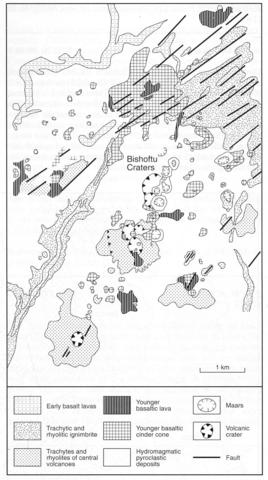stripes
This extensive area southeast of Addis Ababa is wholly occupied by volcanic rocks which fall into four main categories (Gasparon et al., 1993). (1) Early basalts, which are found in linear outcrops along river valleys. (2) Trachytic and rhyolitic ignimbrites with minor intermediate flows and domes. These rocks outcrop extensively in the northeast of the area and form a linear outcrop in the west overlying early basalts. (3) Central volcanoes of which the main ones are Yerer, Bede Gebade and Zikwala (Zuquala); smaller occurrences are Bilbilo, Ruketi and Amenos. Yerer is a composite volcano built principally of silicic and intermediate pyroclastics (Gasparon et al., 1993). Zikwala is 12 km in diameter, has a well preserved cone that rises to 1100 m and a circular summit crater. According to Di Paola (1973) it consists of alkaline trachytes while Gasparon et al. (1993) describe it as consisting of acid lava flows with minor pyroclastics. Bede Gebebe is formed from several coalescing volcanoes and has a number of calderas and post-caldera silicic domes and obsidian flows. The smaller occurrences comprise solely silicic rocks. The numerous whole rock analyses, including much trace element and 87Sr/86Sr data, of Gasparon et al. (1993) indicate that the acid volcanic rocks are peralkaline trachytes and rhyolites. These contain quartz, feldspar, clinopyroxene, olivine and rare amphibole phenocrysts. (4) The fourth and youngest category of rocks are basaltic lavas, spatter and cinder cones and maars with which are also associated intermediate and silicic rocks. The explosion craters in the central part of the area have been described in some detail by Mohr (1961 and 1967b) under the name of Bishoftu craters. There are about a dozen craters, five of which are occupied by permanent lakes, that are rimmed by ejecta in which peralkaline (solvsbergite) blocks are found. Bedded limestones associated with several of the craters are considered to be hot spring deposits and the presence of carbonated springs and peralkaline rock fragments led Mohr (1961) to suggest the possible presence of a carbonatite magma at depth.
GASPARON, M., INNOCENTI, F., MANETTI, P., PECCERILLO, A. and TSEGAYE, A. 1993. Genesis of the Pliocene to Recent bimodal mafic-felsic volcanism in the Debre Zeyt, central Ethiopia: volcanological and geochemical constraints. Journal of African Earth Sciences, 17: 145-65.MOHR, P.A. 1961. The geology, structure, and origin of the Bishoftu explosion craters. Bulletin of the Geophysical Observatory, The University College of Addis Ababa, 2(2): 65-101.MOHR, P.A. 1967b. Further notes on the explosion craters of Bishoftu (Debre Zeit). Bulletin of the Geophysical Observatory, Haile Sellassie I University, Addis Ababa, 10: 99-112.

